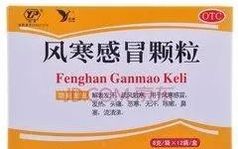The common cold is one of the most prevalent illnesses in our daily lives. In Traditional Chinese Medicine (TCM), the common cold is classified as an external invasion (external evil) disease. Based on clinical symptoms, the common cold is divided into four categories: wind-cold, wind-heat, seasonal, and summer-damp colds. Wind-cold colds are more common in winter and spring, caused by the invasion of wind-cold evil and the failure of lung qi to disperse. The main symptoms include aversion to cold, mild fever, absence of sweating, body aches, headache, nasal congestion, clear nasal discharge, sneezing, itchy throat, mild throat pain, no thirst, thin white tongue coating, and a floating tight pulse.
In TCM, the treatment for wind-cold colds focuses on warming and dispersing the exterior, using warming herbs such as Ma Huang (Ephedra), Jing Jie (Schizonepeta), Fang Feng (Siler), Qiang Huo (Notopterygium), Gui Zhi (Cinnamon Twig), and Su Ye (Perilla Leaf) as the main components. Below, we introduce 10 traditional Chinese medicines for wind-cold colds for your reference:
1. Wind-Cold Cold Granules
Ingredients: Ma Huang (Ephedra), Ge Gen (Kudzu Root), Gui Zhi (Cinnamon Twig), Fang Feng (Siler), Zi Su Ye (Perilla Leaf), Bai Zhi (Angelica Dahurica), Jie Geng (Platycodon), Ku Xing Ren (Bitter Apricot Seed), Chen Pi (Aged Tangerine Peel), Gan Jiang (Dried Ginger), Gan Cao (Licorice).
Indications: Disperse the exterior and induce sweating; used for wind-cold colds, fever, headache, aversion to cold, absence of sweating, cough, nasal congestion, and clear nasal discharge.
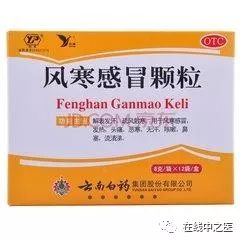
2. Wushi Tea Granules
Ingredients: Cang Zhu (Atractylodes), Chai Hu (Bupleurum), Qiang Huo (Notopterygium), Fang Feng (Siler), Bai Zhi (Angelica Dahurica), Chuan Xiong (Szechuan Lovage), Guang Huo Xiang (Patchouli), Qian Hu (Peucedanum), Lian Qiao (Forsythia), Chen Pi (Aged Tangerine Peel), Shan Zha (Hawthorn), Zhi Shi (Bitter Orange), Chao Mai Ya (Fried Barley), Gan Cao (Licorice), Jie Geng (Platycodon), Zi Su Ye (Perilla Leaf), Hou Po (Magnolia Bark), Hong Cha (Black Tea), Liu Shen Qu (Fermented Barley).
Indications: Disperse wind and resolve the exterior, transform dampness and harmonize the middle. Used for external wind-cold and internal food stagnation, with symptoms of aversion to cold, fever, headache, chest fullness, nausea, vomiting, abdominal pain, and diarrhea.
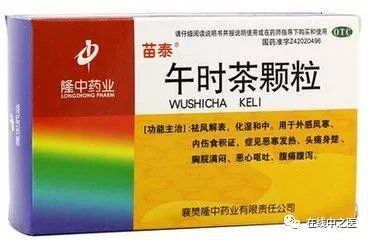
3. Nine Flavor Qiang Huo Granules
Ingredients: Qiang Huo (Notopterygium), Fang Feng (Siler), Cang Zhu (Atractylodes), Xi Xin (Asarum), Chuan Xiong (Szechuan Lovage), Bai Zhi (Angelica Dahurica), Huang Qin (Scutellaria), Gan Cao (Licorice), Di Huang (Rehmannia).
Indications: Disperse wind and resolve the exterior, eliminate cold and dampness. Used for colds caused by external wind-cold, with symptoms of aversion to cold, fever, absence of sweating, heavy headache, and fatigue.
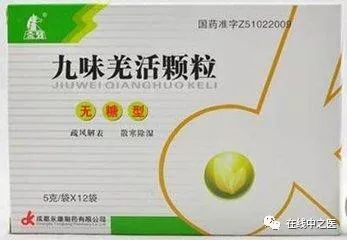
4. Fang Feng Tong Sheng Pills
Ingredients: Fang Feng (Siler), Jing Jie (Schizonepeta), Bo He (Mint), Ma Huang (Ephedra), Da Huang (Rhubarb), Mang Xiao (Glauber’s Salt), Zhi Zi (Gardenia), Hua Shi (Talc), Jie Geng (Platycodon), Shi Gao (Gypsum), Chuan Xiong (Szechuan Lovage), Dang Gui (Angelica Sinensis), Bai Shao (White Peony), Huang Qin (Scutellaria), Lian Qiao (Forsythia), Gan Cao (Licorice), Bai Zhu (Atractylodes, fried).
Indications: Disperse the exterior and clear heat and detoxify. Used for external cold and internal heat, with symptoms of aversion to cold, high fever, headache, dry throat, short red urine, constipation, initial stage of scrofula, and wind rash.
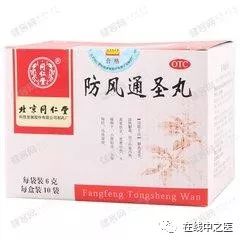
5. Jing Fang Chong Ji
Ingredients: Jing Jie (Schizonepeta), Fang Feng (Siler), Qiang Huo (Notopterygium), Du Huo (Angelica Pubescens), Chai Hu (Bupleurum), Qian Hu (Peucedanum), Chuan Xiong (Szechuan Lovage), Zhi Ke (Bitter Orange), Fu Ling (Poria), Jie Geng (Platycodon), Gan Cao (Licorice).
Indications: Induce sweating and resolve the exterior, disperse wind and eliminate dampness. Used for wind-cold colds, headache, body aches, aversion to cold, absence of sweating, nasal congestion, and runny nose.
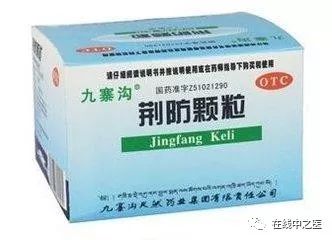
6. Cold Wind Granules
Ingredients: Fang Feng (Siler), Qiang Huo (Notopterygium), Jing Jie (Schizonepeta), Bai Zhi (Angelica Dahurica), Jie Geng (Platycodon), Zhe Bei Mu (Fritillaria), Zi Su Ye (Perilla Leaf), Chen Pi (Aged Tangerine Peel), Ku Xing Ren (Bitter Apricot Seed), Bo He (Mint essential oil).
Indications: Disperse wind-cold and induce mild sweating. Used for wind-cold with runny nose, cough, and headache.
7. Cold Heat Granules
Ingredients: Jing Jie (Schizonepeta), Bo He (Mint), Fang Feng (Siler), Chai Hu (Bupleurum), Zi Su Ye (Perilla Leaf), Ge Gen (Kudzu Root), Jie Geng (Platycodon), Ku Xing Ren (Bitter Apricot Seed), Bai Zhi (Angelica Dahurica), Ku Di Ding (Bitter Herb), Lu Gen (Reed).
Indications: Disperse wind and eliminate cold, resolve the exterior and clear heat. Used for wind-cold colds, headache, fever, aversion to cold, body aches, runny nose, cough, and dry throat.
8. Cold Soft Capsules
Ingredients: Qiang Huo (Notopterygium), Ma Huang (Ephedra), Gui Zhi (Cinnamon Twig), Jing Jie (Schizonepeta), Fang Feng (Siler), Bai Zhi (Angelica Dahurica), Chuan Xiong (Szechuan Lovage), Shi Chang Pu (Acorus), Ge Gen (Kudzu Root), Bo He (Mint), Ku Xing Ren (Bitter Apricot Seed), Dang Gui (Angelica Sinensis), Huang Qin (Scutellaria), Jie Geng (Platycodon).
Indications: Disperse wind and relieve heat. Used for headaches and fever caused by external wind-cold, nasal congestion, runny nose, aversion to cold, absence of sweating, joint pain, and sore throat.
9. Xiao Qing Long Granules
Ingredients: Ma Huang (Ephedra), Gui Zhi (Cinnamon Twig), Bai Shao (White Peony), Gan Jiang (Dried Ginger), Xi Xin (Asarum), Zhi Gan Cao (Honey-fried Licorice), Fa Ban Xia (Pinellia), Wu Wei Zi (Schisandra).
Indications: Disperse the exterior and transform phlegm, stop cough and relieve wheezing. Used for wind-cold with water retention, aversion to cold, fever, absence of sweating, and cough with thin phlegm.
10. Zheng Chai Hu Drink Granules
Ingredients: Chai Hu (Bupleurum), Chen Pi (Aged Tangerine Peel), Fang Feng (Siler), Gan Cao (Licorice), Chi Shao (Red Peony), Sheng Jiang (Fresh Ginger).
Indications: Disperse wind-cold, relieve heat, and alleviate pain. Used for external wind-cold and initial stage of influenza, mild upper respiratory infections.
After a cold, cough should also be treated based on differentiation to avoid arbitrary medication, which may lead to a recurrence of the condition. For cough caused by wind-cold, options include Xiao Ke Chuan (Cough Syrup), Ban Xia Lu (Pinellia Syrup), Xing Su Zhi Ke Tang (Apricot and Perilla Cough Syrup), Zhi Ke Qing Guo Wan (Cough Pill), and Tong Xuan Li Fei Wan (Lung-Resolving Pill).


